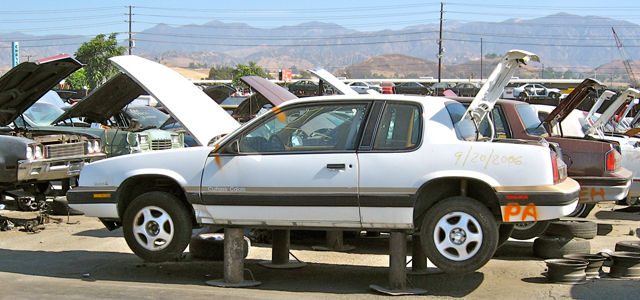 This late eighties front-wheel drive Oldsmobile Cutlass Calias may or may not became a collectors item or the stand as the greatest car ever made. Under the hood is what counts. The General Motors Olds division special, shown here on its final road trip, packed the first production dual overhead cam four-cylinder engine GM ever produced in house. The year? 1987. The engine? The now-legendary GM Quad-4. The first generation Quad-4 engines kicked out about 150-HP – more than some GM small block V8 engines of the same era. A distinctive visual feature of the Quad-4 are the twin camshaft towers, which mirror the configuration of the most legendary of American four-cylinder engines – the Offenhauser. With exception of the Oldsmobile Aerotech, only in an alternate early 90’s universe did GM put a turbocharged Quad-4 into a rear-wheel drive car with fully independent suspension and fully-integrated quad laser. Over half of the boneyards in our world are overflowing with acres of GM front-wheel drive mediocrity as a testament of an era when Detroit well and truly forgot what they did best.
This late eighties front-wheel drive Oldsmobile Cutlass Calias may or may not became a collectors item or the stand as the greatest car ever made. Under the hood is what counts. The General Motors Olds division special, shown here on its final road trip, packed the first production dual overhead cam four-cylinder engine GM ever produced in house. The year? 1987. The engine? The now-legendary GM Quad-4. The first generation Quad-4 engines kicked out about 150-HP – more than some GM small block V8 engines of the same era. A distinctive visual feature of the Quad-4 are the twin camshaft towers, which mirror the configuration of the most legendary of American four-cylinder engines – the Offenhauser. With exception of the Oldsmobile Aerotech, only in an alternate early 90’s universe did GM put a turbocharged Quad-4 into a rear-wheel drive car with fully independent suspension and fully-integrated quad laser. Over half of the boneyards in our world are overflowing with acres of GM front-wheel drive mediocrity as a testament of an era when Detroit well and truly forgot what they did best.





I’m not ashamed to admit I’d rock a Quad 442 (or an Achieva SCX, even).
The Cosworth Vega of 75-76 was GM’s first dual overhead cam engine with 4 valves per cylinder. Only 3500 in total, but that is plenty to count for production.
True, but the Quad-4 was designed and tested in-house by GM. Cosworth designed the DOHC head and did the engine testing for the Vega over in England. You might also find a Cosworth head under the hood of a Chrysler TC, by Maserati.
What a great motor, and I loved the intake manifold on the original Quad4…
I’d love an Achieva SCX. When I had a 95 Grand Am SE (with the QuadOHC motor) I dreamed of having one of those instead.